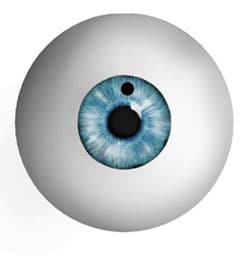Laser iridotomy is a treatment for narrow-angle glaucoma. In laser iridotomy, a small hole is placed in the iris to create a hole for fluid to drain from the back of the eye to the front of the eye. Without this new channel through the iris, intra-ocular pressure can build rapidly causing damage to the delicate optic nerve, and permanent loss of vision. In most patients, the iridotomy is placed in the upper portion of the iris, under the upper eyelid, where it cannot be seen.
The purpose of an iridotomy is to preserve vision, not to improve it.

Laser Iridotomy Is For Those:
- who have been diagnosed with narrow-angle glaucoma.
- whose doctor has determined that laser iridotomy is the appropriate treatment for their condition.
What To Expect On Procedure Day:
Your treatment will be performed in a specially equipped laser room. It does not require a surgery center. Once you have been checked in and settled comfortably, drops will be used to numb your eye; no injections or needles are used.
First, your ophthalmologist will place a drop in your eye to make your pupil smaller. This stretches and thins your iris, which makes it easier for the laser to make the pinhole sized puncture. Next your doctor will place a special contact lens on your eye to focus the laser light upon the iris. This lens keeps your eyelids separated so you won’t blink during treatment. It also reduces small eye movements so that you don’t have to worry about your eye moving during the treatment. To ensure that the contact lens doesn’t scratch your eye, a special jelly will be placed on the surface of your eye. This jelly may remain on your eye for about 30 minutes, leading to blurred vision or a feeling of heaviness.
During the laser treatment, you may see a bright light, like a photographer’s flash from a close distance. Also, you may feel a pinch-like sensation. Other than that, the treatment should be painless.
Your eye pressure will be checked shortly after your procedure and drops may be prescribed to alleviate any soreness or swelling inside your eye. Follow-up visits are necessary to monitor your eye pressure.
Your doctor may ask you to continue using eye drops to make your pupil smaller for a few days following your laser treatment. These drops can temporarily cause blurred vision (especially at night) and may also give you a slight headache. Your doctor may use other drops, both before and after your treatment to control your eye pressure. Still other eye drops may be used to reduce inflammation.
Everyone heals differently, but most people resume normal activities immediately following treatment, although you’ll need to have someone drive you home after your procedure. For the next few days your eyes may be red, a little scratchy and sensitive to light.
Realistic Expectations:
Serious complications with laser iridotomy are extremely rare, but like any medical procedure, it does have some risks. The chance of losing vision following a laser procedure is extremely small. The main risks of a laser iridotomy are that your iris might be difficult to penetrate, requiring more than one treatment session. Another risk is that the hole in your iris will close. This happens in less than one-third of the cases.
Following your procedure, you may still require medications or other treatments to keep your eye pressure sufficiently low. This additional treatment will be necessary if there was damage to the trabecular meshwork prior to the iridotomy or if you also have another type of glaucoma in addition to the closed-angle type.
If you and your doctor decide that laser iridotomy is an option for you, you will be given additional information about the procedure that will allow you to make an informed decision about whether to proceed. Be sure you have all your questions answered to your satisfaction.
If you would like more information about this procedure you can make an appointment or contact the office.
Get In Touch With Us:
To learn more about Hattiesburg Eye Clinic and our services please call us at 601 268 5910 or toll-free at 800 624 8254 or schedule a consultation.
